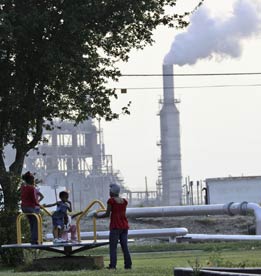By Emma Kerins. This article is part of our August theme, which focuses on the environment and human rights. Read more articles on this theme.
In February of last year, environmental activist and icon Erin Brockovich arrived in Australia to further the cause of what she refers to as “environmental justice”. At the launch of her initiative, the Environmental Justice Society (EJS), Brockovich declared:
This country is at the beginning of a period of huge growth that will continue for decades to come and it’s all driven by the resources in the ground. The EJS will act as a guardian of people’s rights to a safe and healthy environment, and is aiming to help preserve Australia’s pristine beaches, waterways, rainforests and wilderness for generations to come.
The concept of environmental justice has been defined as “the just distribution of environmental risk and benefits amongst the population and the right of all to meaningful participation in environmental decision-making”. However, ironically, it is often seen by some as a cause incompatible with social justice.
Environmental justice, outside of the American context, focuses less on racial discrimination and more on the idea of power politics and the consequences of capitalism.
Some observers claim that prioritising the wellbeing of the environment over promoting industry and growth can only be detrimental to the prospects of poorer communities, which rely on investment from large corporations to create jobs. But this view misrepresents the goals and motivations of the environmental justice movement.
Emerging as a political force in the US during the 1970s as a consequence of racial discrimination, environmental activists come from predominantly low socio-economic backgrounds, made up of minority groups. Women have also tended to play a major role. The environmental justice movement was established to combat specific sources of pollution or toxic wastes, and anything directly affecting the health and quality of life of local communities. Michael Power recently highlighted one such example of environmental justice in action in Australia.
Proponents of environmental justice generally view the environment as encompassing “where we live, work, and play”. They seek to redress unfair distributions of environmental burdens, such as pollution and industrial facilities. Root causes of environmental injustices include institutionalised racism; the co-modification of land, water, energy and air; unresponsive, unaccountable government policies and regulation; and lack of resources and power in affected communities.
The burdens of pollution and industry should be equally shared between all communities
American activist Majora Carter, whose visionary voice has transformed her neighbourhood in the South Bronx through a process of urban renewal combined with environmental sustainability, has claimed that there are direct connections between ecological, economic and social degradation. She has coined the phrase “Green the ghetto!” as the motto for the movement. Her opinion is that race and class are reliable indicators as to where one might find neighbourhoods with parks and trees or what are essentially ghettos filled with power plants and chemical facilities. She explained in a 2006 TED talk:
As a black person in America, I am twice as likely as a white person to live in an area where air pollution poses the greatest risk to my health. I am five times more likely to live within walking distance of a power plant or chemical facility — which I do.
Environmental justice, outside of the American context, focuses less on racial discrimination and more on the idea of power politics and the consequences of capitalism. It particularly seeks to examine how these issues relate to smaller communities who might not have the ability or the means to engage in the processes of governance and decision-making.
In short, it seeks to ensure that communities are engaged in the decision-making process when it comes to planning where a power plant gets built, where a mine might be opened or where a dumping site might be positioned.
This doesn’t mean that it seeks to give the right of veto to all neighbourhoods, indulging the ”not in my backyard” ideology. Environmental justice is not disconnected with the realities of economic growth, energy production or waste disposal. It accepts that these are all necessary consequences of a modern globalised society.
Instead it aims to ensure that it is not just the poorer, politically excluded minority communities who shoulder all the burden of economic expansion. It aims to bind the virtues of environmental protection and social justice, and asks whether it is possible to tackle social exclusion and environmental problems using grassroots initiatives in order to create safer and more sustainable environments. The burdens of pollution and industry should be equally shared between all communities, whether they are made up of the wealthier more influential members of society or the poorer, more politically disengaged minorities.
In Australia, there seems to be a limited willingness to link human wellbeing to environmental protection when it comes to government policy. In general, the issues are often dealt with separately, placing a wedge between government policy makers and environmental activists. It is hoped that with the increased dialogue surrounding environmental justice in Australia, there will evolve a greater willingness to consider the wellbeing of both people and the environment as mutually beneficial as opposed to mutually exclusive goals.



